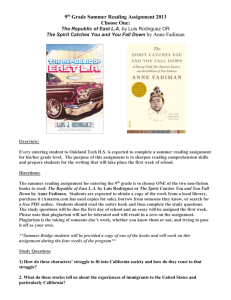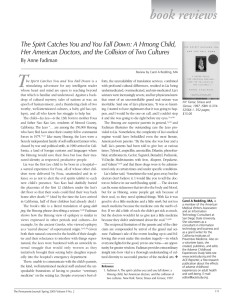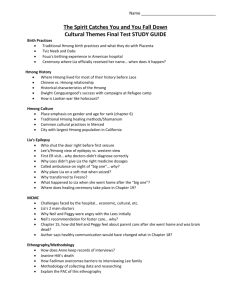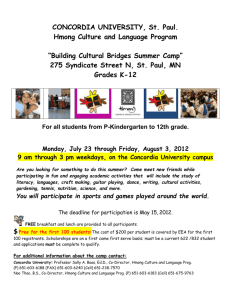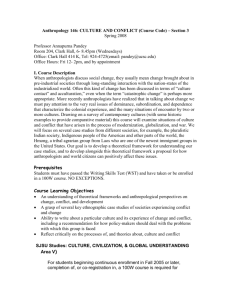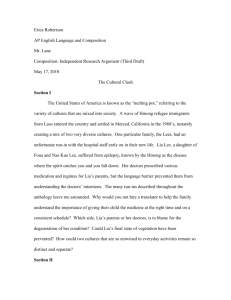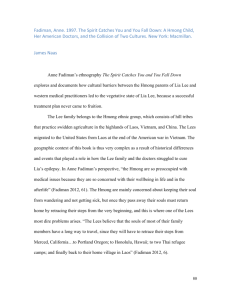Learning across Paradigms in The Spirit Catches You and You Fall
advertisement
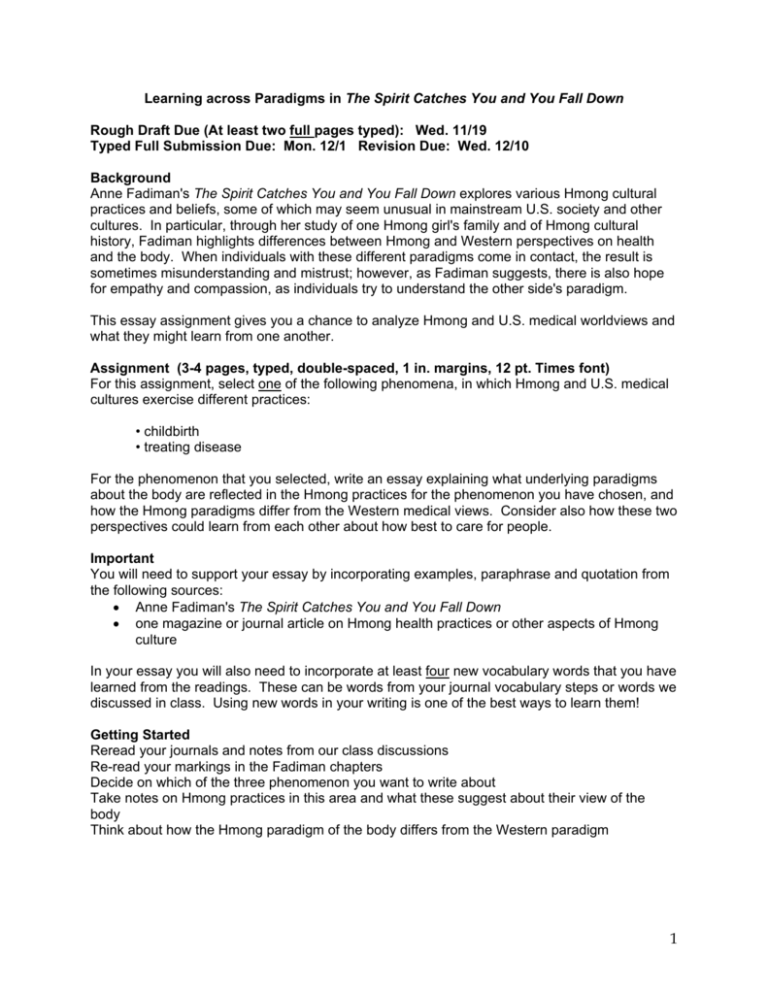
Learning across Paradigms in The Spirit Catches You and You Fall Down Rough Draft Due (At least two full pages typed): Wed. 11/19 Typed Full Submission Due: Mon. 12/1 Revision Due: Wed. 12/10 Background Anne Fadiman's The Spirit Catches You and You Fall Down explores various Hmong cultural practices and beliefs, some of which may seem unusual in mainstream U.S. society and other cultures. In particular, through her study of one Hmong girl's family and of Hmong cultural history, Fadiman highlights differences between Hmong and Western perspectives on health and the body. When individuals with these different paradigms come in contact, the result is sometimes misunderstanding and mistrust; however, as Fadiman suggests, there is also hope for empathy and compassion, as individuals try to understand the other side's paradigm. This essay assignment gives you a chance to analyze Hmong and U.S. medical worldviews and what they might learn from one another. Assignment (3-4 pages, typed, double-spaced, 1 in. margins, 12 pt. Times font) For this assignment, select one of the following phenomena, in which Hmong and U.S. medical cultures exercise different practices: • childbirth • treating disease For the phenomenon that you selected, write an essay explaining what underlying paradigms about the body are reflected in the Hmong practices for the phenomenon you have chosen, and how the Hmong paradigms differ from the Western medical views. Consider also how these two perspectives could learn from each other about how best to care for people. Important You will need to support your essay by incorporating examples, paraphrase and quotation from the following sources: • Anne Fadiman's The Spirit Catches You and You Fall Down • one magazine or journal article on Hmong health practices or other aspects of Hmong culture In your essay you will also need to incorporate at least four new vocabulary words that you have learned from the readings. These can be words from your journal vocabulary steps or words we discussed in class. Using new words in your writing is one of the best ways to learn them! Getting Started Reread your journals and notes from our class discussions Re-read your markings in the Fadiman chapters Decide on which of the three phenomenon you want to write about Take notes on Hmong practices in this area and what these suggest about their view of the body Think about how the Hmong paradigm of the body differs from the Western paradigm 1 Sample journal to precede the assignment on page 1. Here is a sample “Journal” homework assignment that I would assign to students before handing out the essay assignment. Journal #1 1. Read Fadiman, chapter 1 “Birth.” 2. Do a “double-entry” journal for the chapter. In the left-hand column, write down notes and quotes from passages describing specific Hmong childbirth practices. In the right-hand column, write down what we might infer about the Hmong paradigm(s) of the body from these practices. (1-2 pages) Notes/Quotes on Hmong childbirth practices Hmong paradigm(s) of the body reflected in these practices p. 5—Placenta Burying: “Soon after the birth, while the mother and baby were still lying together next to the fire pit, the father dug a hole at least two feet deep in the dirt floor and buried the placenta.” After child grows up to be an adult and dies, the soul needs to be able to find the placenta and put it on like a jacket or “it is condemned to an eternity of wandering” The soul is closely connected to physical body parts. 2 Sympathetic Portrayals of People and their Paradigms Rough Draft Due (At least two full pages typed): Wed. 1/28 Typed Full Submission Due: Mon. 2/9 Revision Due: Mon. 2/23 Background Critics reviewing Anne Fadiman’s book The Spirit Catches You and You Fall Down have praised Fadiman’s ability to present various people in a balanced, sympathetic way: “[This book] has no heroes or villains”—Melvin Konner, The New York Times Book Review “Fadiman's ability to empathize with the resolutely independent Hmong as well as with the remarkable doctors, caseworkers, and officials of Merced County makes her narrative both richly textured and deeply illuminating.”--Michael Berube, author of Life As We Know It “A wonderful aspect of Fadiman's book is her evenhanded, detailed presentation of these disparate cultures and divergent views--not with cool, dispassionate fairness but rather with a warm, involved interest. -- Carole Horn, The Washington Post Book World In this paper, you get to think about Fadiman as a writer, specifically how she portrays the characters in her book in such a way that readers sympathize with them, despite their differing paradigms. Assignment (3-4 pages, typed, double-spaced, 1 in. margins, 12 pt. Times font) 1. Select one of the central people in Fadiman’s account whom you have found particularly compelling (i.e, appealing, attractive, and/or interesting) and with whom you sympathized with in some way. You can choose from the following list of people, but if you have another person you would rather select, let me know. Nao Kao Lee Foua Yang Neil Ernst Peggy Philp Jeanine Hilt Dee Korda 2. Write an essay explaining what Fadiman does as a writer that makes this person appealing to you and that leads you to sympathize with his/her ideas and actions, even if you do not agree with them. In your essay you can consider how Fadiman portrays the person through such elements as: • details she gives about the person’s thoughts • specific word choices she makes in describing the person • quotes she uses from the person • quotes she uses from others talking about the person • information she gives about the person’s background • her descriptions of the person interacting with others To find sections of the book where Fadiman presents your selected person, use the index in the back of the book; look up the person by last name. Important • Quote and paraphrase from Fadiman in supporting your points. • Use MLA style for both in-text citations and your Works Cited page • Incorporate and underline at least four new vocabulary words that you have learned from the readings. Getting Started Start by rereading your journals and notes on our class discussions. Then think about what person you want to select. After this, use the index to find all of the sections in the book where Fadiman presents this person. Take notes on what Fadiman is doing in each of these sections. 3 Immigrant Encounters See Due Dates below Backgound In several of her chapters (most notably chapters 14 and 16, but other chapters as well), Fadiman describes challenges that the Hmong have experienced as immigrants to the U.S. This paper assignment gives you an opportunity to compare Hmong immigrant experiences with those of another U.S. immigrant group, to reflect on what we can learn from your comparison, and to integrate various research sources in developing your arguments. Assignment 1. Select a U.S. immigrant group that you are interested in and/or feel some connection with (e.g., Nicaraguans, Mexicans, Lebanese, Chinese, Koreans, Cambodians, Cubans, Vietnamese, Pacific Islanders, Ethiopians, etc.). 2. Write an 5-6 page essay in which you: a. compare several aspects of your selected group’s experiences in the U.S. to the experiences of the Hmong. You can point out both similarities and differences between these groups’ experiences. AND b. reflect on what we can learn from your comparison (e.g., about human beings, cultures, immigrants, etc.) In developing your points, you need to incorporate the following sources: • Fadiman’s descriptions of Hmong immigrant experiences • your personal experiences with and/or observations of the immigrant group you selected • an interview with someone from your selected immigrant group • at least three published research sources (books and/or articles from well-respected journals, newspapers or magazines) • (optional) material from a respected organization’s website Important • Quote and paraphrase from your sources in supporting your points. • Use MLA style for both in-text citations and your Works Cited page • Incorporate and underline at least four new vocabulary words that you have learned from the readings. Steps and Due Dates in this Assignment To help you complete this assignment, I have broken it down into several steps, each with its own due date. Part I. My interest in this immigrant group (1-2 pages) Due Mon. 2/16 Describe the immigrant group that you have chosen to research and compare to the Hmong. Explain why you have chosen this immigrant group and what knowledge you already have of this group’s experiences in the U.S. Describe who you think you could interview from this group about their experiences. Also explain what you think at this point about how the experiences of this group may be similar to or different from those of the Hmong. 4 Part II. Interview (8-12 interview questions, plus at least two pages of your interviewee’s responses). Due. Mon. 2/23 1. Develop a set of interview questions to ask your interviewee about their interview experiences. 2. Conduct the interview and turn in a copy of the interviewee’s responses to your questions. You may wish to tape-record the interview; if you do, make sure to get your interviewee’s permission. Part III. Summaries of Relevant Ideas in My Sources (1 page for each summary) Due. Wed. 2/25 In this section, for two of your published research sources, include a 1 page summary of important information in the source. You do not need to summarize every detail in the source but rather focus on issues that are important for addressing a point you want to make in your essay. For each summary, you should do the following: 1. At the top of the page, write down the full citation of the source in MLA style. 2. In the first sentence, introduce the author and title of the source along with a general summary statement of what the author is discussing in this source 3. Then, in 1-2 paragraphs, summarize several important pieces of information the author presents that are relevant to points you want to make in your essay. In your summary, you should mainly use your own words to describe what the author has said (this is called paraphrasing). However, you should support your paraphrases with short quotes from the author. Part IV—Summaries (cont.) (1 page for each summary) Due. Mon. 3/2 Do summaries for two more of your sources, following the guidelines for Part III. Part V. My outline, introduction, and one sample body paragraph for my argument Due Wed. 3/4 1. Make an outline of your argument that includes your thesis statement and points of support. 2. Write an introduction for your argument. Your introduction should end with your thesis statement. (Later on you can change your statement if necessary so that it is a better umbrella for your essay.) 3. After your introduction, write one body paragraph that presents one of your points of support for your thesis, integrating paraphrase and quotation from at least two of your sources. Obviously your actual essay will include more than one body paragraph, but for this part of the assignment, you only need to develop one body paragraph of support. So make it a strong one and make sure that you avoid plagiarizing from your original sources! Use the summaries you wrote of your sources to help you. Also, remember that this body paragraph is only focused on one support from your outline, so do not try to put all the points from your outline in this one paragraph! Part VI. The Rest of My Argument Body and Conclusion (Mon. 3/9) For the rest of your essay body: Write the rest of your body paragraphs, incorporating the various sources of support you have gathered. Refer back to your source summaries and your outline for guidance. 5 Cross-Paradigm Communication Rough Draft due Mon. 3/23 Background In the final chapters of her book, Anne Fadiman presents different ways that U.S. medical staff could communicate more effectively with patients from different cultures. Although Fadiman’s concern is specifically with doctor-patient communication, some of the ideas from her book might be applied to various situations in which people are coming from different paradigms. This paper assignment gives you an opportunity to reflect on how Fadiman’s book can help you maneuver within a challenging communication situation. Assignment (2-3 pages, typed, double-spaced, 1 in. margins, 12 pt. Times font) 1. Think about a situation in which you need to negotiate with someone who has a very different viewpoint from your own. a. This person might be a parent, a sibling, a boy/girlfriend, a friend, an instructor, an employer, or someone else. b. The situation should involve something that you and the person view with very different paradigms. 2. Write an essay that responds to the following question: What insights from Fadiman’s book can help you communicate effectively with the person and reach some common understanding about the situation? Important • Quote and paraphrase from Fadiman in supporting your points. • Use MLA style for both in-text citations and your Works Cited page • Incorporate and underline at least four new vocabulary words that you have learned from the readings. Getting Started Think about the person you want to select and the situation that you view differently. Take notes on ideas from Fadiman that could help you communicate with that person about the situation. 6
